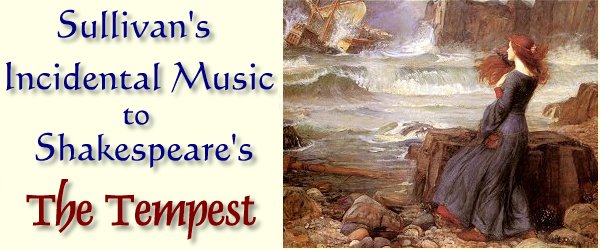You are here: > > > The Tempest
- Introduction
- Reviews
- Of the first performance at the Crystal Palace, 1862, from The Times
- Of a performance at the Crystal Palace, 1868, from The Times
- Marc Shepherd's The Tempest Discography
- MIDI Files of the music
- Full score and parts published by The Amber Ring.
- Download the score, arranged for piano duet
[Part 1, 4.7MB] [Part 2, 3.9MB
INTRODUCTION
Sullivan composed his incidental music to Shakespeare's The Tempest during the last few months of 1860 and the early months of 1861. Six movements, the Introduction, Ariel's song, an Entr'acte, the Grotesque Dance, Entr'acte and Epilogue and the Dance of they Nymphs and Reapers, were given their first performance at the Haupt-Prüfung or Graduation Concert held at the Leipzig Gewendhaus on 6th April 1861 which marked the end of Sullivan's time as a student at the Leipzig Conservatoire.
The music was well received both by the audience in the hall that evening - Sullivan was called to the platform to take his bow three times - and by the Leipzig press. The Neue Zeitschrift für Music commented:
Mr Arthur Sullivan, from London, produced music for Shakespeare's The Tempest which showed him strongly influenced by Schumann, and to some extent Mendelssohn. The last movement, 'Dance of Nymphs and Reapers', with its skipping flirtatious rhythms, won hearty applause. The composer handles the orchestral medium skilfully, and achieves charming effects.
On his return to London, Sullivan made some revisions to the score and, almost a year after the Leipzig performance, the work, now extended to twelve movements, was given its first London performance at the Crystal Palace under the baton of August Manns. For this performance, Henry Chorley, the music critic of the Athenaeum wrote a narration to be spoken during the melodrama which Sullivan had composed envisaging that the music might eventually be used during a performance of the play.
The work was an immediate success with five of the movements being encored. The Times reported:
Enough at present to say that his music to The Tempest, while betraying a strong partiality for Mendelssohn's fascinating style, exhibits remarkable merits, and among the rest a decided vein for melody, a strong feeling of dramatic expression, and a happy fancy in the treatment of the orchestra...At the conclusion there was a loud call for 'the composer' who was greeted with the heartiest applause on all sides.
On the morning of 5th April 1862, few had heard of Sullivan. That evening he became famous and his career as a composer was triumphantly launched. So great was the success of the concert that it was repeated the following week. A vocal score was issued with accompaniment for piano duet. Sullivan dedicated the work to Sir George Smart, the organist of the Chapel Royal where Sullivan had been a chorister and a member of the committee who had awarded Sullivan the Mendelssohn Scholarship.
In January 1863, The Tempest was performed twice under Charles Hallé in Manchester where it was received with the same enthusiasm as had been demonstrated at the Crystal Palace and in October 1864 it was used, as Sullivan had intended all along, in a production of the play at the Prince's Theatre in that city.
Paul Howarth
Page modified 22 December 2009
